Pekka Buttler, July 2021
Introduction
Focus shift is an issue photographers might encounter when they are focusing the lens wide open, but stop it down for taking a picture. Focus shift is a further complication (typically1) arising from spherical aberration, so if you have not read that article, please do before going on. Because, however, the amount of focus shift a lens suffers cannot be deduced from the amount of spherical aberration it shows, and because methods to live with focus shift differ from those used to deal with spherical aberration, focus shift deserves an article of its own.
This article is part of a JAPB series of articles on the optical flaws of lenses and you can find the index of the series here.
What is focus shift and what causes it?
In the simplest terms: a lens that has a focus plane (the plane where focus is optimal) that moves backwards or forwards as the lens is stopped down suffers from focus shift.
The main cause of focus shift is based on the existence of spherical aberration wide open. Because spherical aberrations leads to that while some rays (from any point source on the focal plane) focus on the film/sensor plane, other rays focus both in front of and behind the film/sensor. This not only lessens how well the entire image is in focus (again, refer to the article on spherical aberration), but also shifts the apparent overall optimum focus.
When the lens is stopped down, and those rays that previously produced spherical aberration are excluded, the point of apparent optimum focus shifts.
Therefore, when an SLR photographer composes and focuses wide open, then stops down (either automatically or manually) for the shot, it may turn out that optimum focus was not where it seemed to be. Refer to the illustrations below.
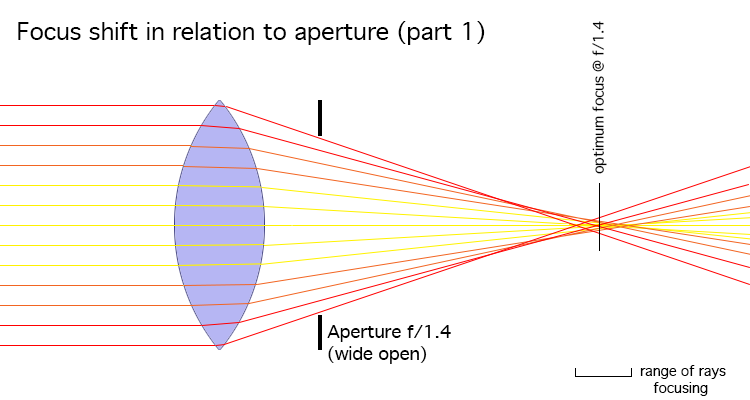
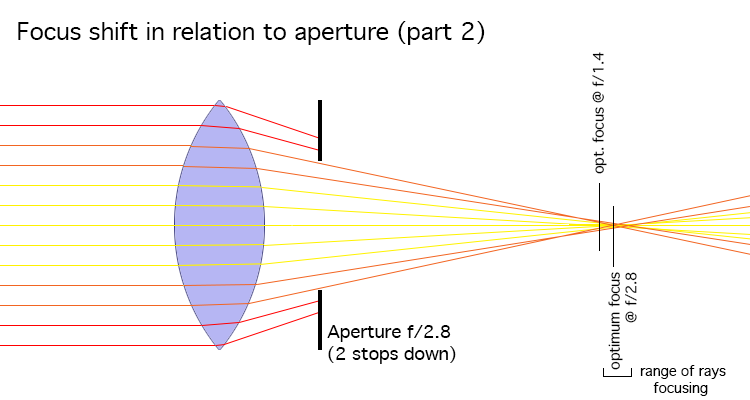

Obviously, these illustrations exaggerate the effect significantly (to make the it clearly visible), but the principle holds. Two caveats however need to be stated:
• Firstly, while these illustrations show the point of optimum focus moving away from the lens as it is stopped down, this need not be the case. While most lenses that suffer from focus shift seem to shift focus away from the lens as it is stopped down, there are exceptions.
• Secondly, while these illustrations show the point of optimum focus to move only in one direction, this – again – need not be the case. Due to the complex interactions of multiple lens elements, optimum focus may first move away from the lens only to then reverse direction etc.
How bad is focus shift?
Indeed, based on the text and illustrations above, focus shift might sound bad, even terminal, if it were not for one important aspect: the increase in depth-of-field that follows from stopping down. Lets have a look at some simple figures:
Say you’re focusing on a close range (60 cm) object with a normal (≈50 mm) lens. The lens is a fast fifty (50/1.4), and focusing is done wide open. With those settings (60 cm distance; 50 mm lens; f/1.4) depth-of-field is 1,1 centimetres. The depth-of-field range of such a lens focused at 60 centimetres would be from 59,45 cm to 60,57 cm. See table below for some more DOF-figures2.
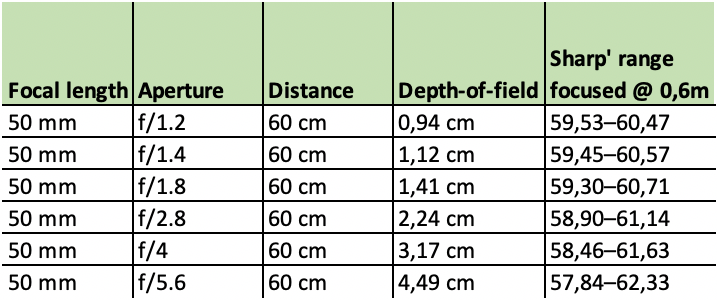
Enter spherical aberration. Due to spherical aberration, rays that come through different parts of the lens come together (focus) at different distances from the lens. This leads to that optimum focus (the focus distance at which the object in the wide-open shot looks sharpest) may be either short of or behind the actual distance (60 centimetres).
Therefore, when you take the wide-open shot (having focused wide open), focus is about where it should be, albeit that the entire image may look soft and lacking in contrast due to spherical aberration. But who expects a lens – especially a legacy lens – to be tack-sharp wide-open? That’s why you should stop down to get sharp results, right?
Problematically, stopping down may result in a picture that has more sharpness, but that sharpness may be somewhere else as the spherical aberrations that confused your MkI eyeball and (most) AF systems is now gone.
Let’s take an example: Assume you have an object at 60 cm distance, but due to spherical aberration it looks at its sharpest when you set lens A to 62 cm. Wide open it looks as soft as one assumes a lens to be wide open, but when you stop down to f/2.8 most of the spherical aberration is gone and you notice that your lens (which is focused at 62 cm) is not at all focused correctly.
Alternatively, on lens B the image may look sharpest (wide open) when the lens is set to focus at 60,5 cm and when you stop down that (60,5) is clearly within the lens’ depth-of-field and the result is maybe not perfect, but perfectly useable.
Importantly, you cannot deduce the amount of focus shift based on the (subjective) amount of spherical aberration (softness, lack of contrast) wide open. Assuming the difference between real optimum wide-open focus (including spherical aberration) and theoretical optimum wide-open focus (without spherical aberration) is small (less than one percent of focusing distance), the impact of focus shift will not be massive, but may nevertheless show on close inspection as mild front- or back-focusing.
Examples
The following examples show the varying focus shift behaviour with nine normal lenses: three superfast fifties (50-55 mm f/1.2); three fast fifties (50-57 mm f/1.4); and three nifty fifties (50 mm f/1.8). All pictures were taken in unchanging circumstances with in-camera variation minimised (ISO 100, WB Cloudy) on a tripod and with a 2 second timer. The test setup is depicted below:
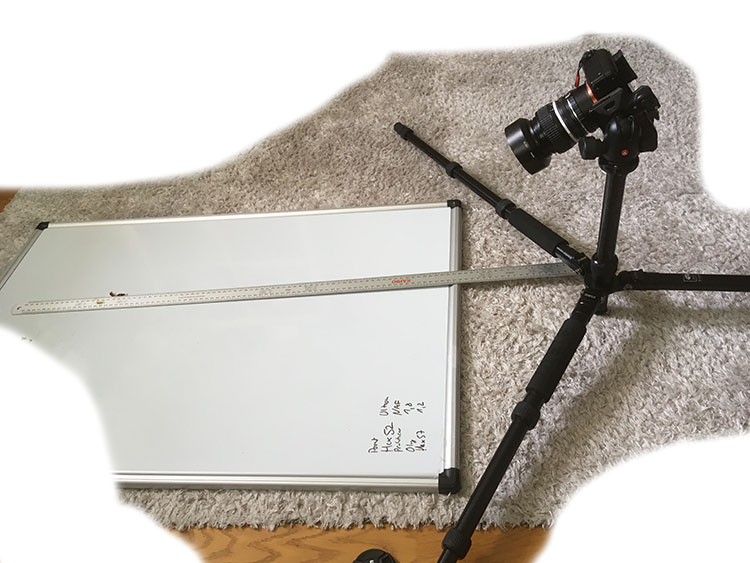
The beginning of the ruler was set under the camera, and focus was set with the lens wide open (and left alone after that). Focus was ascertained with maximum focus magnification and set at the 500 mm point of the ruler (and as the camera was ≈36 cm higher than the ruler, Pythagoras (x2 + y2 = z2) gives us a focusing distance of ≈ 60 cm (in line with the theoretical calculations above). One picture was always taken wide open, another at f/2.8 and a third at f/5.6. The resulting images were converted in ACR default, then aligned manually and cropped to 243×650 each (no other edits).
The composites below show the three crops (at wide open, at f/2.8, and at f/5.6), and the green bar is added to show where (I think) focus was at its best (I used the purple/green shift associated with longitudinal chromatic aberrations to ascertain where the lens had focused).
As you will see (when you scroll down):
• The amount of softness and lack of contrast (wide open) is a poor predictor of the amount of focus shift suffered.
• Expensive lenses did not (in general) outperform poor lenses, not even within the same category (f/1.2 vs. f/1.4 vs. f/1.8).
• Some lenses have negligible focus shift, while other lenses show focus shift that can only be described as extreme.
• In this test a clear majority (7/9) of lenses evidenced some focus shift, with several showing significant focus shift. While I think this is indicative of focus shift in this class of lenses (fast, standard, legacy primes), there are other types of lenses that are less prone to focus shift.
f/1.2 lenses
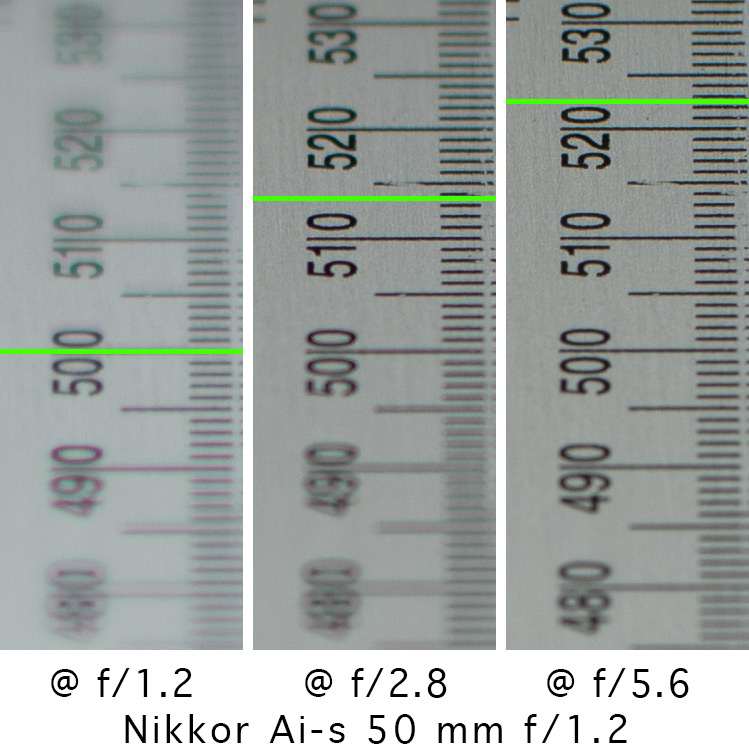
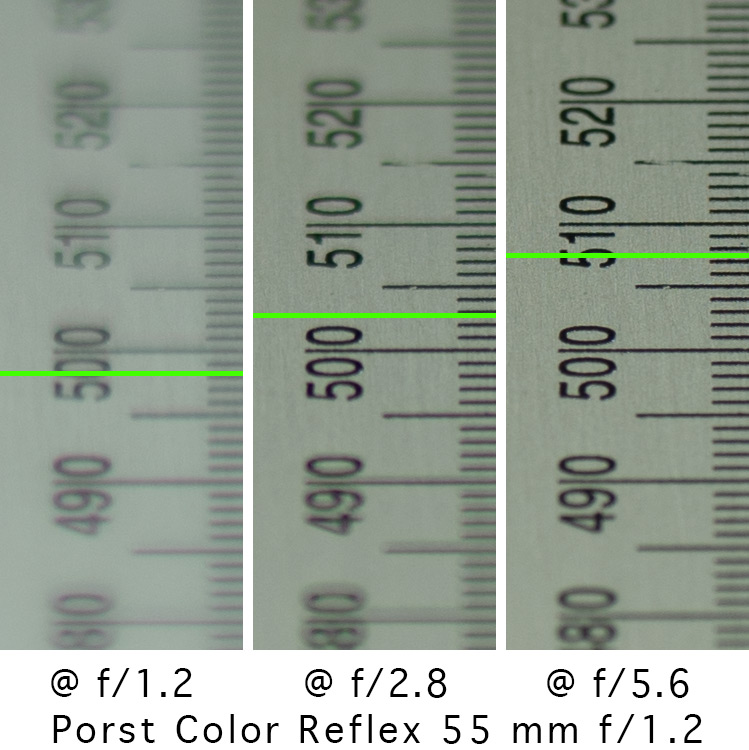
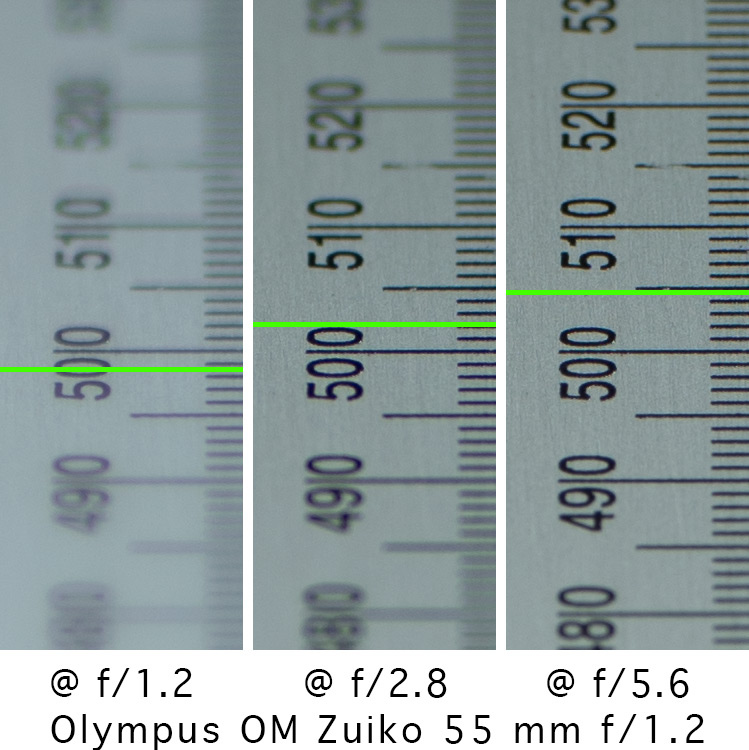
The superfast Nikkor shows significant focus shift, while the (relatively) much cheaper Porst shows a lot less focus shift. Interestingly, while the Porst has only some focus shift, it does suffer the worst from spherical aberrations (wide open). Of these three lenses the Olympus shows the least focus shift.
f/1.4 lenses

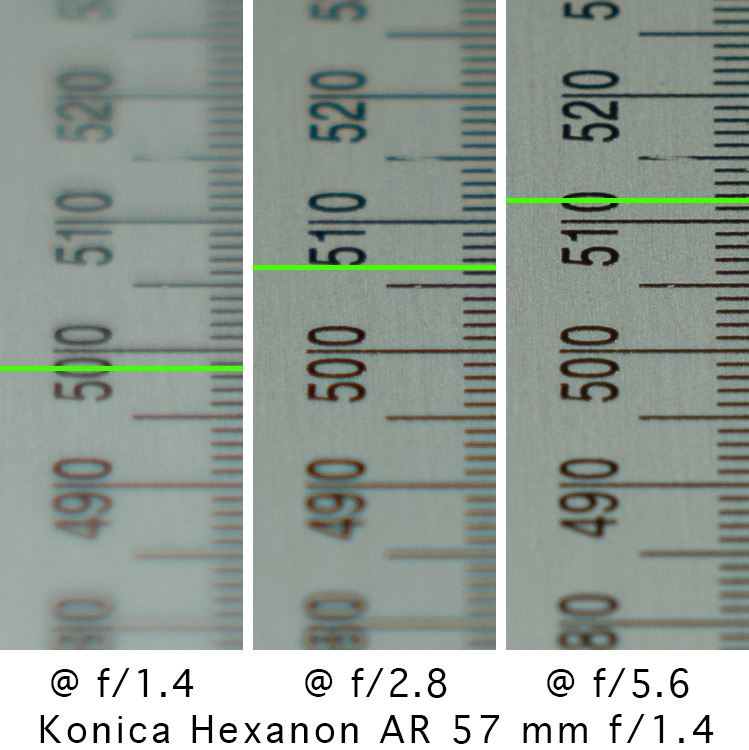
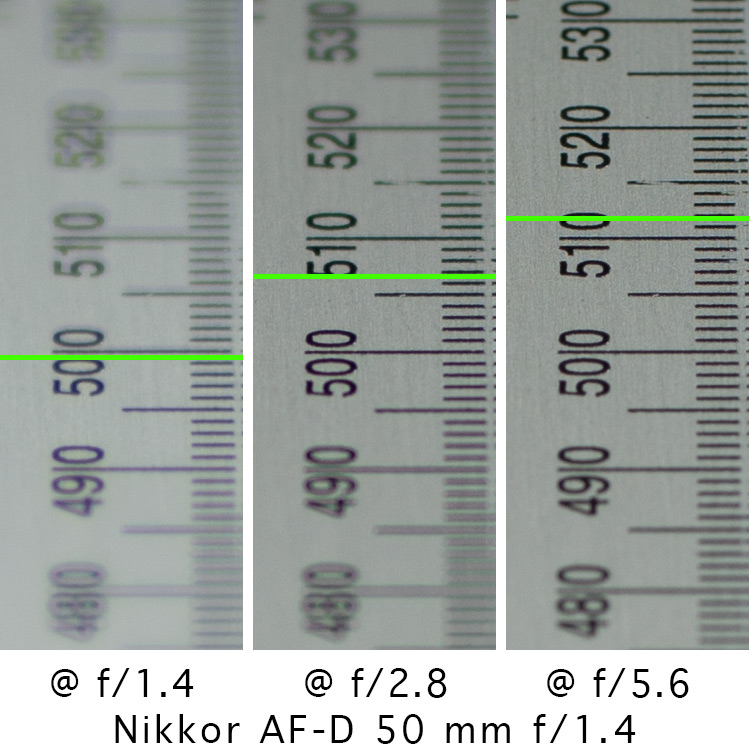
Both the (semi-modern) autofocus Nikkor and the decidedly legacy 57 mm Konica show significant (albeit not extreme) focus shift. The even older Konica F-mount 52 mm Konishiroku however shows very little focus shift and the main direction of that modest shift is toward the camera, thereby differing significantly from all lenses tested here.
f/1.8 lenses
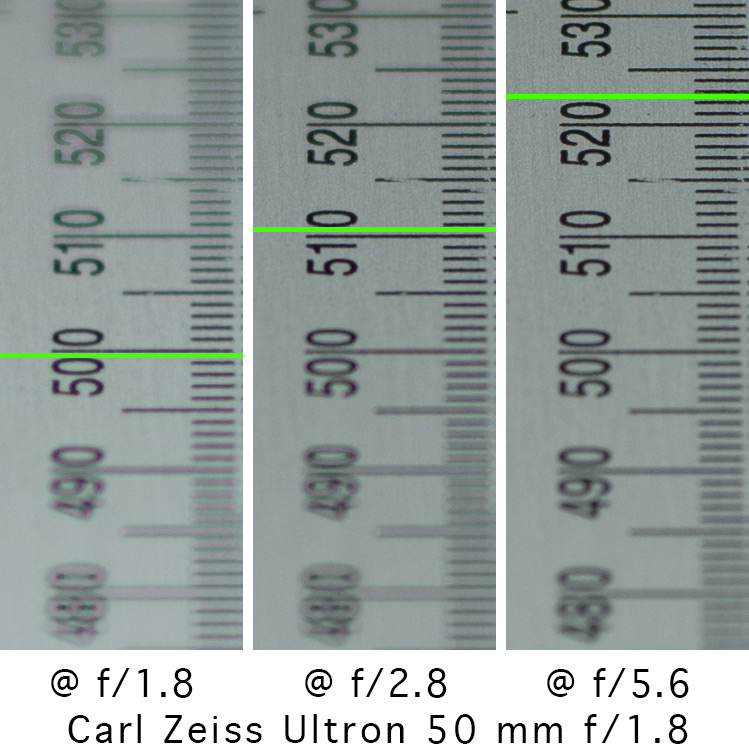
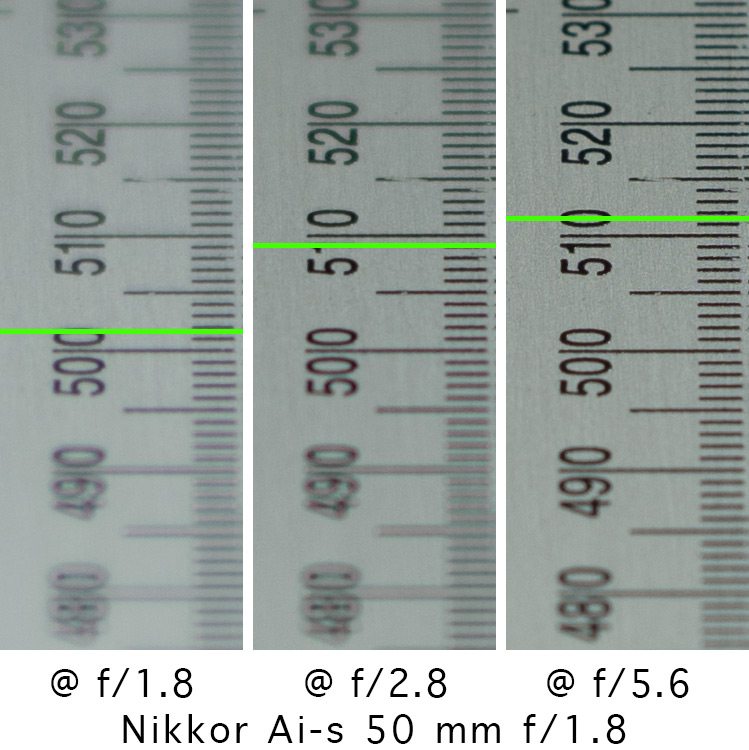
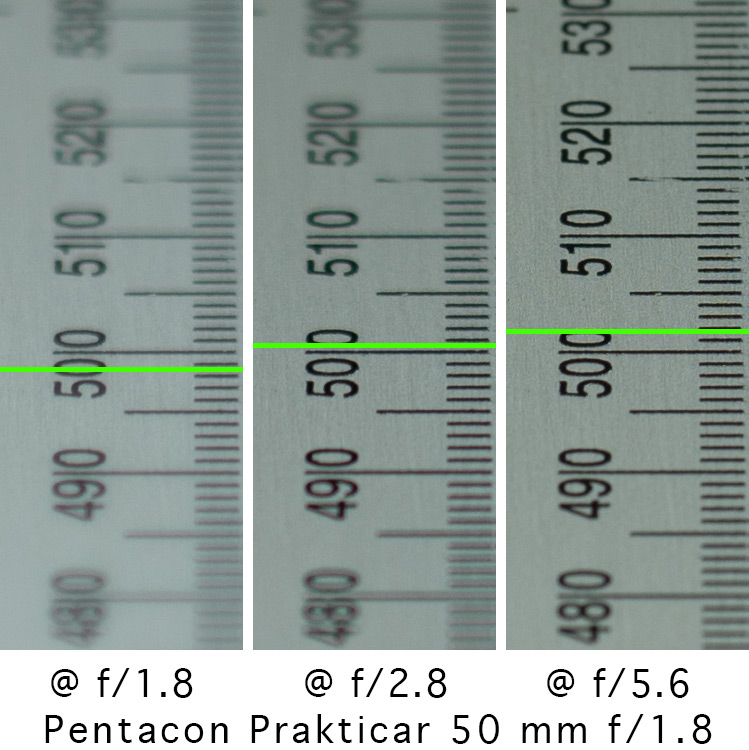
This last batch contains a wide price range of lenses – from the < 50€ Pentacon Prakticar (Praktica B mount) to the vastly more expensive (and quite legendary) Carl Zeiss Ultron. It is therefore especially interesting to see how badly the Ultron performs with regards to focus shift (The Ultron’s focus shift: 23 mm from f/1.8 to f/5.6, has to be considered worse that the Nikkor 50/1.2’s: 23 mm from f/1.2 to f/5.6). Instead the less legendary f/1.8 Nikkor shows a semi-decent result and the very mundane Pentacon wipes the floor with the entire rest of the tested lenses (with the exception of the Konishiroku).
The fact that the Ultron simultaneously with producing dismal amounts of focus shift manages to defend its reputation as a lens with exceptional wide-open contrast and definition clearly shows, that although focus shift may be a side-effect of spherical aberration, the amount of spherical aberration is not an good predictor for focus shift.
One important note:
Focus shift is at best a nuisance, but it progresses beyond the level of mere nuisance if and when the focus shift is so extensive, that the increase in depth-of field is not sufficient to compensate for the shift in focus. One can judge whether this threshold is passed either mathematically or using one’s eyeballs:
Going by depth-of-field charts (see above) the increase in D-O-F going from f/1.4 to f/2.8 is (at these distances) 1,12 cm, roughly half of this being in front and the other behind the focus plane. Considering the angle of these shots, the threshold for focus shift would be (on the ruler):
• 8 mm from f/1.2 to f/2.8
• 7 mm from f/1.4 to f/2.8
• 5 mm from f/1.8 to f/2.8
Below those threshold values focus shift is a nuisance; above those values focus shift is a real issue.
Based on this criteria, the following lenses (in alphabetical order) fail the test: Carl Zeiss Ultron 50/1.8; Konica Hexanon AR 57/1.4; Nikkor AF-D 50/1.4; Nikkor Ai-s 50/1.2; and Nikkor Ai-s 50/1.8
The other way is based on using one’s eyes. The simplest way is to look at the point of focus at wide open, and stopped down, and looking at whether the point of focus is sharper stopped down than wide open. If, for instance, one looks at the composite of crops from the Ultron above, one can clearly see that the ‘500’ is significantly less sharp at f/2.8 than wide open, and even at f/5.6 it’s a tad equivocal.
Based on this criteria, the Carl Zeiss Ultron 50/1.8 and Nikkor Ai-s 50/1.2 fail the test, but some other lenses struggle as well (they might show improved contrast, but not improved definition).
Addressing focus shift while shooting
There are basically two ways to address focus shift: focusing closed down to the taking aperture and compensating for focus shift. The latter is clearly more difficult and liable to be less precise, but sometimes the only alternative.
As focus shift is caused by how the closing down of the aperture changes the field of focus, the simplest and most precise method is to focus with the lens closed down to the taking aperture. This is inherently not an issue when using mirrorless cameras and manual lenses and even many dSLR’s allow this nicely in live view. Also, as long as the taking aperture is relatively bright (f/5.6 or brighter) many dSLR’s AF systems will be able to cope with autofocusing when closed down, and those photographers using split screens or micro-prisms in manual focusing will be able to discern focus. Should the intended taking aperture be darker than f/5.6, the only option is to focus (automatically or manually) using the darkest aperture that still allows to focus, then stopping down to the taking aperture (focus shift beyond f/5.6 largely becomes a non-issue).
But there are cases where the above approach is basically impossible, namely those when previewing does not happen through-the-lens. Most prominently, this issue occurs with viewfinder-, rangefinder- and twin-lens-reflex (TLR) cameras. In these cases the best one can do is to try to learn the focus shift characteristics of one’s lens and guesstimate the necessary compensation, then dialling in that compensation. That said, with these types of cameras the actual issue is often not in compensating for stop-down focus shift, but is instead in trying to compensate for the change in focus caused by wide-open spherical aberration.
Footnotes
1 In some very rare occasions focus shift can also be caused by (or exacerbated by) longitudinal chromatic aberrations, but this would necessitate a very strongly saturated and monochromatical (monochromatically coloured) object.
2 All Depth-of-field calculations and numbers presented here are based on the depth-of-field -calculator available on photopills.com.